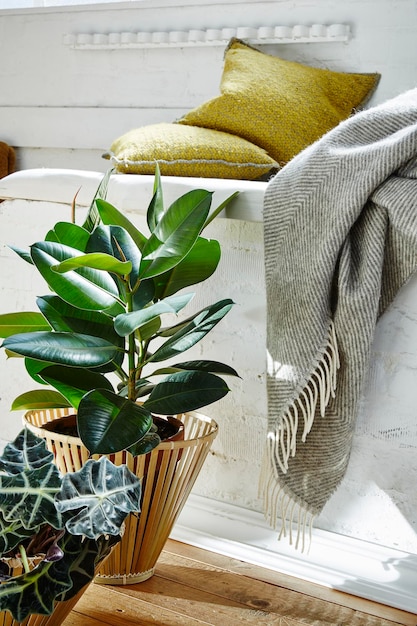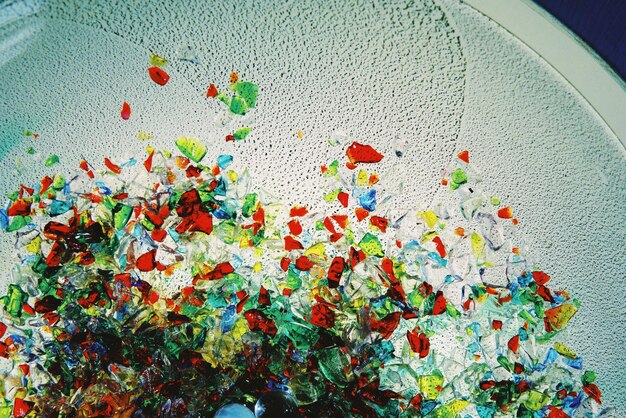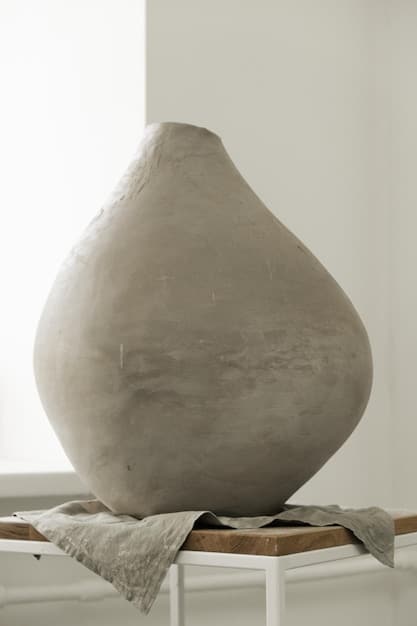Sustainable Home Decor: Eco-Friendly Materials for Your Home

Embracing sustainable home decor involves thoughtfully selecting eco-friendly materials and practices that minimize environmental impact, fostering a healthier living space while reducing your carbon footprint.
The pursuit of a beautiful home doesn’t have to come at the Earth’s expense. As awareness grows regarding environmental impact, the concept of sustainable home decor: decorate your home with eco-friendly materials and reduce your impact has transcended niche appeal to become a mainstream movement. This approach invites us to reimagine our living spaces, prioritizing materials and practices that respect both our planet and our well-being.
The Core Principles of Sustainable Decor
At its heart, sustainable decor is about conscious consumption and mindful design. It’s an alignment of aesthetic desires with ecological responsibility, moving beyond fleeting trends towards lasting impact. This philosophy shapes every decision, from the origin of a piece to its eventual end-of-life, encouraging a holistic perspective on interior design.
Understanding the Environmental Footprint of Decor
The journey of a piece of furniture or decor item often begins with resource extraction, proceeds through manufacturing, transportation, and finally, disposal. Each stage carries an environmental burden, contributing to greenhouse gas emissions, pollution, and resource depletion. Sustainable decor aims to mitigate these impacts by fostering choices that prioritize longevity, renewable resources, and minimal waste.
- Resource Efficiency: Opting for materials that are abundant, renewable, or made from recycled content.
- Reduced Waste: Minimizing landfill contributions through durable products and circular economy principles.
- Lower Emissions: Choosing items manufactured with less energy and transported efficiently.
- Healthier Interiors: Avoiding toxic chemicals commonly found in conventional furniture and finishes.
By understanding these implications, homeowners can make informed decisions that translate into tangible environmental benefits. It’s not merely about buying “green” products, but about adopting a mindset that values durability, timelessness, and ecological integrity.
Furthermore, this approach often intertwines with social responsibility, supporting fair labor practices and local economies. The interconnectedness of these principles underscores the depth and breadth of what it means to truly embrace sustainable living within our homes. It shifts the focus from purely aesthetic gratification to a more profound sense of purpose and contribution.
Choosing Eco-Friendly Materials: A Deep Dive
The foundation of sustainable home decor lies in the materials chosen. These materials range from traditional, time-tested options to innovative, newly developed alternatives, all sharing a common thread: a reduced environmental impact. Identifying and understanding these materials is crucial for making genuinely eco-conscious choices.
Sustainable Wood: Beyond Just ‘Wood’
Not all wood is created equal when it comes to sustainability. The key distinctions lie in how it’s sourced and processed. Opting for wood from certified sustainable forests, reclaimed sources, or fast-growing varieties minimizes deforestation and supports responsible forestry. This ensures that the timber used in your furniture or flooring has a story of regeneration, not destruction.
- FSC Certified Wood: Guarantees wood comes from responsibly managed forests.
- Reclaimed & Salvaged Wood: Gives new life to old timber, reducing demand for new logging.
- Bamboo: A rapidly renewable grass with a wood-like appearance, ideal for flooring and small furniture.
Beyond its sourcing, consider the finish on wood products. Water-based, low-VOC (Volatile Organic Compound) stains and sealants are preferable to solvent-based alternatives, which can off-gas harmful chemicals into your home environment. The durability of wood also plays a role; well-crafted wooden pieces can last for generations, reducing the need for frequent replacements.
Natural Fibers: Softness with a Conscience
For textiles, from upholstery to rugs and curtains, natural fibers offer a breathable, often biodegradable, and more sustainable alternative to synthetic options. However, the environmental impact of natural fibers varies significantly based on cultivation methods.
- Organic Cotton: Grown without harmful pesticides or synthetic fertilizers.
- Hemp & Linen: Require less water and fewer pesticides than conventional cotton.
- Jute & Sisal: Durable, natural fibers ideal for rugs, often grown with minimal environmental impact.
When selecting natural fibers, inquire about their dyeing processes. Natural dyes or low-impact dyes are superior to conventional synthetic dyes, which can release pollutants into water systems. The longevity of a textile item is also paramount; investing in high-quality, durable fabrics means fewer replacements and less waste over time.
Mineral-Based and Recycled Materials
Beyond natural plant fibers and wood, a diverse array of mineral-based and recycled materials offers robust and eco-friendly options for various decor elements. These materials often boast exceptional durability and contribute to a circular economy, diverting waste from landfills.

Recycled glass, for instance, can be transformed into stunning countertops, tiles, and decorative objects. Its production uses significantly less energy than manufacturing new glass. Similarly, recycled metal, like aluminum or steel, finds new life in lighting fixtures, furniture frames, and sculptures, reducing the need for virgin ore extraction and its associated environmental costs.
Terra cotta, ceramic, and natural stone, while requiring energy for extraction and processing, are incredibly durable and long-lasting, making them sustainable choices for flooring, pottery, and decorative accents. Their natural origins also mean they are free from the synthetic chemicals often found in engineered materials. The inherent beauty and resilience of these materials align perfectly with a sustainable ethos, creating lasting appeal that transcends fleeting trends.
Beyond Materials: Sustainable Practices and Habits
Sustainable home decor isn’t solely about what you buy; it’s equally about how you interact with your belongings and your space. Adopting sustainable practices and habits can significantly amplify the positive impact of your material choices, fostering a truly eco-conscious home environment.
Embracing the “Reduce, Reuse, Recycle” Mantra
The classic three R’s remain foundational to any sustainable lifestyle, and they are particularly relevant in home decor. Reducing consumption is often the most impactful step, challenging the impulse for constant upgrades and favoring mindful purchasing.
- Reduce: Evaluate needs before buying. Do you truly need that new item, or can you repurpose something you already own?
- Reuse: Look for opportunities to give old items new life. Think about restoring vintage furniture or repainting existing pieces.
- Recycle & Upcycle: When an item truly reaches the end of its life, ensure it’s recycled properly. Upcycling takes this a step further, transforming waste materials into new products of higher value.
Shopping secondhand, visiting antique shops, and exploring online marketplaces for pre-loved items are excellent ways to practice reuse. These choices not only prevent items from going to landfills but also often provide unique, characterful pieces at a fraction of the cost of new items.
Upcycling can involve simple projects like turning old tires into unique outdoor seating or more complex endeavors like transforming vintage suitcases into creative storage solutions. This practice requires ingenuity and a willingness to see potential in discarded items, leading to truly one-of-a-kind decor that tells a story.
Supporting Local and Ethical Production
The globalization of manufacturing has brought convenience but often at an environmental and social cost. Supporting local artisans and businesses that adhere to ethical production standards is a powerful way to promote sustainability.
When you purchase from local makers, you reduce the carbon footprint associated with long-distance shipping. Furthermore, local craftspeople often use traditional techniques, work with regionally sourced materials, and operate under fair labor practices. This strengthens local economies and preserves artisanal skills.

Investigating the story behind a product, understanding its origins, and learning about the people who made it adds another layer of appreciation to your decor choices. This transparent approach fosters a deeper connection to your home items, moving away from anonymous mass-produced goods towards pieces with a genuine narrative and positive impact.
The Connection Between Health, Well-being, and Sustainable Decor
A truly sustainable home doesn’t just benefit the planet; it also profoundly impacts the health and well-being of its inhabitants. The choices made in decor can significantly influence indoor air quality, mental serenity, and overall physical comfort.
Indoor Air Quality: A Hidden Benefit
Many conventional decor items, from furniture to paints and fabrics, can off-gas Volatile Organic Compounds (VOCs) and other harmful chemicals. These substances contribute to poor indoor air quality, which can lead to a range of health issues, including respiratory problems, headaches, and allergies.
Sustainable decor, by contrast, emphasizes non-toxic materials and finishes. Natural paints, low-VOC adhesives, formaldehyde-free furniture, and organic textiles significantly reduce the chemical load in your home. This creates a healthier breathing environment, particularly beneficial for children, pets, and individuals with sensitivities.
Beyond material choices, incorporating indoor plants is an effective natural air purifier. Certain plants, like peace lilies and snake plants, are known to filter common indoor pollutants, adding both aesthetic beauty and functional benefits to your space.
Creating a Calming and Harmonious Environment
The very essence of sustainability often aligns with principles of biophilic design, which seeks to connect occupants with the natural environment. Incorporating natural elements, textures, and light can foster a sense of calm and well-being within the home.
- Natural Light: Maximizing natural light reduces reliance on artificial lighting, saving energy and boosting mood.
- Biophilic Elements: Integrating plants, natural wood, and stone connects the indoor space with the outdoors.
- Mindful Clutter: A sustainable approach often leads to less clutter, promoting a more organized and serene environment.
A home filled with natural materials, handcrafted items, and meaningful pieces tends to evoke a deeper sense of tranquility and authenticity. This thoughtful curation contributes not just to visual appeal, but to an overall feeling of peace and groundedness, transforming a house into a truly nurturing haven.
Navigating Challenges and Common Misconceptions
While the path to sustainable home decor is rewarding, it’s not without its challenges and common misconceptions. Addressing these can help individuals make more informed and practical choices without falling prey to “greenwashing” or feeling overwhelmed.
The Cost Factor: Investment vs. Expense
One common misconception is that sustainable decor is always more expensive. While some eco-friendly options might have a higher upfront cost, it’s crucial to view this as an investment rather than a mere expense. High-quality, durable, and ethically produced items are built to last, reducing the need for frequent replacements.
Consider the lifecycle cost: a furniture piece made from sustainable, sturdy wood might cost more initially than a mass-produced item made from particleboard, but the former will likely last decades, potentially saving money in the long run. Additionally, the health benefits of non-toxic materials can contribute to reduced healthcare costs.
Furthermore, many sustainable options, particularly those involving repurposing, upcycling, or buying secondhand, can be incredibly budget-friendly. The ‘do-it-yourself’ approach inherent in much sustainable decor can also be a significant cost-saver, transforming existing items into new treasures.
Avoiding Greenwashing and Making Informed Choices
As sustainability gains popularity, so does greenwashing – the deceptive practice of marketing products as environmentally friendly when they are not. Navigating this landscape requires a critical eye and a willingness to do a little research.
- Look for Certifications: Reputable third-party certifications (e.g., FSC for wood, GOTS for organic textiles) provide assurance of environmental standards.
- Read Labels Carefully: Be wary of vague terms like “eco-friendly” without specific details or certifications.
- Research Companies: Investigate a company’s overall commitment to sustainability, not just a single product line.
- Ask Questions: Don’t hesitate to inquire about material sourcing, manufacturing processes, and labor practices.
The goal is to empower yourself with knowledge. Understanding what truly constitutes a sustainable product helps bypass misleading claims and supports genuinely responsible businesses. It’s an ongoing learning process, but one that becomes easier with practice and a committed mindset towards genuine ecological integrity.
Sustainable Decor in Every Room: Practical Applications
Translating sustainable principles into actionable decor choices can be applied to every room in your home, turning each space into a testament to mindful living. From the bustling kitchen to the tranquil bedroom, eco-conscious options abound.
Living Room: Comfort with a Conscience
The living room, often the heart of the home, offers numerous opportunities for sustainable choices. Start with large furniture pieces. Opt for sofas with frames made from FSC-certified wood and upholstery from organic cotton, linen, or recycled fabrics. Look for cushions filled with natural latex or wool instead of conventional foam.
Rugs can be made from jute, sisal, or recycled plastic bottles (RPET). For lighting, choose fixtures made from recycled metals or sustainably sourced wood, and always use LED bulbs for energy efficiency. Decorative items can include vintage finds, pottery from local artisans, or art made from recycled materials. Consider natural wood coffee tables or side tables finished with non-toxic sealants.
Bedroom: A Sanctuary of Sustainable Slumber
Creating a sustainable bedroom focuses on promoting restful sleep while minimizing environmental impact. The bed is central: aim for a frame made from solid, sustainably sourced wood or reclaimed timber. Mattresses can be a significant source of VOCs; look for organic latex, wool, or cotton options that are free from harmful chemicals and flame retardants.
Bedding should ideally be organic cotton, linen, or hemp. These materials are breathable, durable, and free from pesticide residues. Nightstands and dressers can be vintage pieces restored or new items crafted from sustainable wood. Minimize electronic devices to promote better sleep and consider natural air purifiers like plants to enhance air quality.
Kitchen & Dining: Functionality Meets Eco-Consciousness
The kitchen and dining areas are prime locations for sustainability. For dining tables and chairs, choose solid wood from certified sources or explore durable, recycled metal options. Consider bamboo or cork flooring, known for their renewability and durability.
For kitchenware, opt for ceramic or glass storage containers over plastic. Tableware can include recycled glass or ceramics, and cutting boards made from bamboo or sustainably sourced wood. Incorporate natural light whenever possible and use LED lighting. For decor, consider living herbs in planters, or bowls of fresh, seasonal produce.
Even small details matter: choose reusable beeswax wraps over plastic cling film, and use natural fiber dishcloths instead of synthetic sponges. These seemingly minor changes collectively contribute to a significantly reduced environmental footprint within your kitchen.
Future Trends and the Evolving Landscape of Sustainable Decor
The field of sustainable home decor is dynamic, continually evolving with new innovations, materials, and design philosophies. Staying abreast of these trends can offer fresh perspectives and exciting opportunities for eco-conscious home design.
Technological Advancements and Material Innovation
Science and technology are playing an increasingly vital role in developing new sustainable materials. We’re seeing advancements in bio-based materials, such as mushroom mycelium, which can be grown into furniture forms, offering fully biodegradable alternatives to traditional foams and plastics. Materials like recycled ocean plastic are being transformed into durable fabrics and decor items, directly addressing the monumental issue of plastic pollution.
Smart home technologies, when designed with energy efficiency in mind, can also contribute to sustainability by optimizing light, temperature, and appliance use. Predictive systems that learn your habits can minimize energy waste, subtly contributing to greener living without sacrificing comfort.
Furthermore, innovations in manufacturing, such as 3D printing with recycled materials, promise to reduce waste and allow for localized production, cutting down on transportation emissions. These advancements suggest a future where sustainable options are not just alternatives but become the default, driven by both ecological necessity and technological ingenuity.
The Circular Economy and Design for Disassembly
A major trend shaping the future of sustainable decor is the move towards a circular economy. This model contrasts with the traditional “take-make-dispose” linear approach by emphasizing resource recovery, reuse, and regeneration. In decor, this means designing products from the outset to be easily disassembled, repaired, and repurposed at the end of their first life cycle.
- Modular Design: Furniture pieces that can be easily reconfigured or repaired, extending their lifespan.
- Take-Back Programs: Manufacturers offering to take back old products for recycling or refurbishing.
- Material Passports: Detailed information about a product’s materials, making recycling and reuse easier.
This shift represents a fundamental rethinking of how products are designed and consumed. It fosters a system where waste is minimized, and resources are kept in use for as long as possible. As consumers, supporting brands that embrace these principles is key to accelerating this transformative change.
The future of sustainable home decor is not static; it’s a journey of continuous improvement and adaptation. By embracing new ideas, supporting innovative companies, and continuing to make conscious choices, individuals can play a significant role in shaping a greener, more responsible future for interior design.
Maintaining a Sustainable Home: Cleaning, Care, and Longevity
Adopting sustainable home decor goes beyond the initial choices of purchasing eco-friendly items; it extends to how these items are maintained and cared for over time. Proper cleaning and care practices are essential for prolonging the lifespan of your decor, reducing waste, and ensuring a healthy living environment.
Eco-Friendly Cleaning Practices
The cleaning products used in your home can significantly impact indoor air quality and water systems. Conventional cleaning solutions often contain harsh chemicals that are not only detrimental to your health but also can pollute waterways. Shifting to eco-friendly cleaning methods aligns perfectly with a sustainable home ethos.
- Natural Ingredients: Utilizing ingredients like vinegar, baking soda, lemon juice, and essential oils for effective and non-toxic cleaning.
- Reusable Tools: Opting for reusable cleaning cloths and sponges made from natural fibers instead of disposable wipes.
- Bulk Purchase: Buying cleaning supplies in bulk or concentrated forms to reduce packaging waste.
Making your own cleaning solutions is often simple, cost-effective, and ensures you know exactly what ingredients are being used. This approach minimizes exposure to synthetic fragrances and dyes, which can be irritants for many individuals. A clean home can be a green home, without compromise on effectiveness.
Caring for Your Sustainable Investments
Sustainable decor items, particularly those made from natural materials, often require specific care to maintain their beauty and integrity over time. Understanding how to properly clean and protect your eco-friendly furniture, textiles, and finishes is crucial for maximizing their lifespan.
For wooden furniture, regular dusting with a soft cloth and occasional polishing with natural wood waxes can prevent drying and cracking. Avoiding harsh chemical cleaners is paramount, as they can strip natural finishes. Organic cotton and linen textiles benefit from gentle washing cycles with eco-friendly detergents and air drying whenever possible to conserve energy.
By investing a little time and effort in proper care, you ensure that your sustainable decor pieces remain beautiful and functional for many years, truly embodying the principle of longevity. This mindful maintenance reduces the need for frequent replacements, saving resources and contributing to a more sustainable consumption pattern.
The holistic approach of sustainable living truly manifests when initial choices are supported by ongoing habits and practices. From the moment an item enters your home to its continued care, every action contributes to a larger tapestry of environmental responsibility and well-being.
| Key Aspect | Brief Description |
|---|---|
| 🌳 Sustainable Materials | Prioritize FSC-certified wood, organic cotton, hemp, and recycled content to minimize environmental impact. |
| 🔄 Reduce, Reuse, Recycle | Embrace secondhand shopping, upcycling, and mindful consumption to reduce waste and ecological footprint. |
| 🧘 Healthy Home Environment | Choose non-toxic, low-VOC products to improve indoor air quality and promote well-being. |
| 🔍 Informed Choices | Look for certifications, research brands, and avoid greenwashing for genuine sustainable impact. |
Frequently Asked Questions About Sustainable Home Decor
▼
An eco-friendly material typically has a minimal environmental impact throughout its lifecycle, from sourcing to disposal. Key characteristics include being renewable, recycled, non-toxic, durable, and produced with low energy consumption and minimal pollution. Certifications like FSC and GOTS help verify these claims, ensuring materials meet specific environmental standards.
▼
While some new sustainable products might have a higher upfront cost due to ethical production and quality materials, sustainable decor can be highly affordable. Options like buying secondhand, upcycling, DIY projects, and choosing durable items that last longer often save money in the long run. Viewing it as an investment in longevity and health helps justify costs.
▼
Begin by assessing what you already own for repurposing or upcycling. Gradually replace items with sustainable alternatives as needed, prioritizing natural, non-toxic materials. Start small, perhaps with organic textiles or second-hand decorative pieces. Focus on reducing new purchases and adopting eco-friendly cleaning habits to maintain your existing decor.
▼
Greenwashing is when a company deceptively markets products as environmentally friendly without genuine commitment or evidence. To avoid it, look for credible third-party certifications, research the company’s overall environmental practices, read product labels carefully for specific details, and don’t be swayed by vague “eco” claims without substance. Ask direct questions about sourcing and production.
▼
Key sustainable habits include adopting the “reduce, reuse, recycle” philosophy by minimizing consumption and embracing secondhand finds. Supporting local artisans and ethical brands reduces carbon footprints and promotes fair labor. Practicing eco-friendly cleaning and caring for items properly extends their lifespan, reducing waste and contributing to a conscious home.
Conclusion
Embracing sustainable home decor is more than a trend; it’s a commitment to a lifestyle that values the planet and personal well-being equally. By making conscious choices about materials, supporting ethical production, and adopting mindful practices, we can transform our living spaces into beautiful, healthy, and environmentally responsible sanctuaries. This journey is continuous, marked by evolving insights and innovative solutions, proving that a stylish home and a healthy planet can indeed coexist harmoniously.





